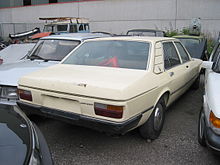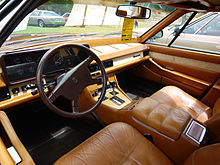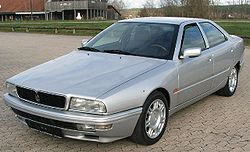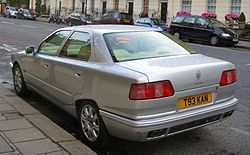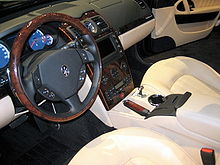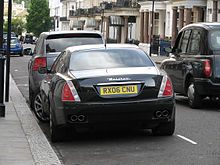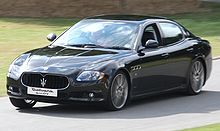- Maserati Quattroporte
-
Maserati Quattroporte 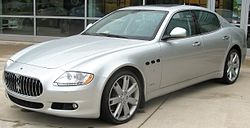
Manufacturer Maserati Production 1963–1969, 1974–1990, 1994-2001, 2004–present Assembly Modena, Italy Class Full-size luxury car Body style 4-door saloon The Maserati Quattroporte is a luxury four-door saloon made by Maserati in Italy. The name translated from Italian literally means "four doors". There have been five generations of the car, each separated by a period of roughly five years.
Contents
Quattroporte I (1963–1969)
First generation 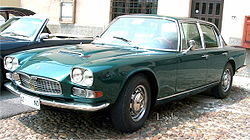
Production 1963-1969 Layout FR layout Engine 4.1L 256 hp (191 kW) V8
4.7L, 295 hp (220 kW) V8Transmission 5-speed manual
3-speed automaticWheelbase 2,700 mm (110 in) [1] Length 5,000 mm (200 in) Width 1,690 mm (67 in) Height 1,525 mm (60.0 in) Curb weight 1,700 kg (3,700 lb) Related Maserati Sebring
Maserati 3500
Maserati MexicoIn the early 1960s, Maserati's reputation was at a high. With growing sales, Prince Karim Aga Khan ordered a special Maserati 5000 WP, chassis no. 103,060, designed by Pietro Frua. The following year, Maserati showed the first-generation Quattroporte of 1963, which bore a striking resemblance to the earlier drawing. While the design was by Frua, construction was carried out by Vignale.
This, the 1963 'Tipo 107' Quattroporte, joined two other notable grand tourers, the Facel Vega and the Lagonda Rapide, which could comfortably do 200 km/h (124 mph) on the new motorways of Europe. However, the Quattroporte could be said to have been the first car specifically designed for this purpose.
It was equipped with a 4.1 L (4,136 cc/252 cuin) V8 engine, producing 256 hp (SAE) (191 kW) at 5,600 rpm, and either a five-speed ZF manual transmission or a three-speed automatic. Maserati claimed a top speed of 230 km/h (143 mph).
Between 1963 and 1966, 230 examples were made.
In 1966, Maserati revised the Tipo 107, adding twin headlights (already on the US model) and, from 1968, a 4.7 L, 295 hp (SAE) (220 kW) engine. Top speed increased to a claimed 255 km/h (160 mph).[2] Around 500 of the second series were made, for a total of 776 Tipo 107 Quattroportes. Production stopped in 1969.[3]
In 1971, Karim Aga Khan ordered another special on the Maserati Indy platform. Rory Brown was the chief engineer. It received the well known 4.9 litre V8 engine (Tipo 107/49), producing 300 PS (221 kW).[4] Carrozzeria Frua clothed the car, the prototype of which was displayed in Paris 1971 and Geneva 1972.[5] The car was production ready, even receiving its own chassis code (AM 121), but Citroën used their influence to have Maserati to develop the SM-based Quattroporte II instead.[6] In the end only two were finished, chassis #004 was sold by Maserati to the Aga Khan in 1974 and the prototype #002 went to the King of Spain, who bought his directly from Frua.[5]
Quattroporte II (1974–1978)
Second generation 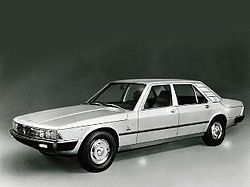
Production 1976-1978 Layout MF layout Engine 3.0 L Tipo AM 114.56.30 DOHC V6 Transmission 5-speed manual Related Citroën SM In 1974, at the Turin Show, Maserati presented its Quattroporte II (AM 123)[5] on an extended Citroën SM chassis, available since Citroën had purchased the Italian company. It had sparse and slick Bertone bodywork, penned by Marcello Gandini and fashionable at the time, and was the only Maserati Quattroporte to feature hydropneumatic suspension and front wheel drive. It also had the swivelling directional headlights à la SM/DS. However, the 1973 oil crisis intervened. This, combined with the collapse of the Citroën/Maserati relationship, made Maserati unable to gain EEC approval for the car. Most of the cars built were thus sold in the Middle East and in Spain, where such type approval wasn't necessary.[4]
Furthermore, the front-wheel drive layout and the modest V6 3.0L powerplant based on the Citroën SM engine didn't attract many customers. Its 210 PS (154 kW) at 5,500 rpm was barely enough to propel the 1,600 kg (3,500 lb) car to 200 km/h (124 mph). Maserati's traditional customers simply wouldn't consider the car a true Maserati. Maserati made 13 Quattroporte IIs. While the prototype was built in 1974, the succeeding twelve cars were built to order between 1976 and 1978.[4] The nearly stillborn Quattroporte II project was very costly for the small company, which found itself in debt to the tune of four billion lire by the end of 1978.[4]
Quattroporte III/Royale (1979–1990)
Third generation 
Also called Royale Production 1979-1990 Layout FR layout Engine 4,136 cc 255 PS (188 kW; 252 bhp) V8
4,930 cc 280 PS (206 kW; 276 bhp) V8
4,930 cc 300 PS (221 kW; 296 bhp) V8[7]Transmission 3-speed automatic,
optional ZF 5-speed manualRelated Maserati Kyalami Designer Giorgetto Giugiaro Considered a "business man's Maserati," the Quattroporte III was presented by newly empowered Maserati chief Alejandro de Tomaso and his design staff in 1977. This was a rear wheel drive car, powered by a large V8 engine. It was important to de Tomaso that there be an Italian vehicle to compete with the recently launched Mercedes-Benz 450SEL 6.9. The Quattroporte III marked the last of the hand-built Italian cars. All exterior joints and seams were filled to give a seamless appearance.
In 1976, Giorgetto Giugiaro presented two ItalDesign show cars on Maserati platforms, called the Medici I and Medici II. The latter in particular featured hallmarks which would make it into the production of the third-generation Quattroporte. At the 1977 Turin Motor Show, Maserati announced the Quattroporte III (Tipo AM 330), which took much from the Medici show cars, based on Maserati's Kyalami coupé, which in turn was based on the De Tomaso Longchamp. Special styling emphasis was placed on linearity, which was also useful to reduce tooling cost.
The Quattroporte III went into production in 1979,[8] equipped with a 4,136 cc V8 engine (confusingly referred to as "4200" by Maserati) producing 255 hp (188 kW),[8] later 238 hp (SAE) (177 kW)[citation needed]. Also available was a 4.9 litre V8 (280 hp @ 5800 rpm[8]). One distinguishing characteristic of the vehicle was its particularly lavish interior. The automatics initially used a three-speed Borg–Warner automatic transmission, soon replaced by a Chrysler Torqueflite gearbox. Manual gearboxes were ZF-built 5-speeds. The smaller engine was phased out in 1985.
In 1986, the Maserati Royale, a handbuilt to order ultra-luxury version of the Quattroporte III, appeared. The engine was upgraded to 295 hp (SAE) (220 kW).
In all, 2,155 Quattroporte IIIs were produced,[7] one of them for Italian presidential use. Production ceased in 1990. Turinese coachbuilder Salvatore Diomante also offered a 65 cm longer limousine version, fully equipped with white leather, "abundant burr walnut", mini-bar, video recorder and many other necessities. The price of the Diomante limousine at introduction (1986) was a rather steep 210 million lire.[7]
The production figures for the Quattroporte are as follows:
- There were 1876 Quattroporte III's produced between 1979 and 1988.[citation needed]
- There were 1821 standard 4portes manufactured between 1979 and 1984.[citation needed]
- The remaining 55[citation needed] or 53[7] cars were Royales, manufactured between late 1986 and 1990. These were US$80,000 cars that were built to order only.
Quattroporte IV (1994–2001)
Fourth generation Production 1994-2001 Layout FR layout Engine 1,996 cc, 287 PS (211 kW) V6
2,790 cc, 284 PS (209 kW) V6
3,217 cc, 335 PS (246 kW) V8Wheelbase 2,650 mm (104.3 in) Length 4,550 mm (179.1 in) Width 1,810 mm (71.3 in) Curb weight 1,543–1,647 kg (3,402–3,631 lb) Related Maserati Ghibli II
Maserati ShamalThe Quattroporte IV from 1994 was a restyled and updated version of the 430, the four-door version of the Biturbo coupe. It was designed by Marcello Gandini, also known for penning the Lamborghini Countach, Urraco, Espada, Miura, Lancia Stratos, and Bugatti EB110. The new car was smaller, very aerodynamic (0.31 cd), and featured Gandini's trademark angular rear wheel arch.
A 2.8 L twin turbo V6 was installed, producing 284 PS (209 kW), reaching a top speed of 255 km/h (158 mph) while the Italians even had a "tax special" 2 litre version producing 287 PS (211 kW) on their price list. Both engines came from the familiar Maserati Biturbo engine catalog. The 2.8 was not even offered in the home market until a year after its introduction.[9] A V8 3.2 L Biturbo was announced in 1995, coming from the Maserati Shamal, developing 335 PS (246 kW) and reaching an approximate 270 km/h (168 mph).
After Ferrari took over Maserati in July 1997, it introduced a Quattroporte Evoluzione for 1998. It featured 400 new or improved parts out of a total 800, and also benefitted from improvements to Maserati's manufacturing methods.[9] The Evoluzione saw the famous oval Maserati clock disappear from the interior. Production ended in May of 2001.
Quattroporte IV[9] Units Produced Production Period 2.0i V6 24v 587 1994-1998 2.8i V6 24v 668 1994-1998 3.2i V8 32v 415 1996-1998 2.0i V6 Evoluzione 200 1998-2001 2.8i V6 Evoluzione 190 1998-2001 3.2i V8 Evoluzione 340 1998-2001 Total 2400 1994-2001 Quattroporte V (2004 – present)
Fifth generation 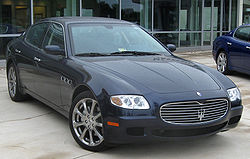
Production 2004-present Layout FMR layout Engine 4.2L 400 PS (294 kW) V8
4.7L 430 PS (316 kW) V8
4.7L 440 PS (324 kW) V8Transmission 6-speed automatic
6-speed DuoSelect paddle-shiftWheelbase 3063 mm (120.6 in) Length 2004-06: 5,052 mm (198.9 in)
2009-present: 5,097 mm (200.7 in)Width 1895 mm (74.6 in) Height 1438 mm (56.6 in) Curb weight 1,990 kg (4,387 lb) Related Ferrari California
Maserati GranTurismo
Maserati GranCabrio
Alfa Romeo 8C Competizione
Alfa Romeo PandionIn 2004, Maserati started production of the Pininfarina-designed Quattroporte, with the same dry sump 4.2 L engine as the Coupé, Spyder and the new GranTurismo but improved to 400 PS (294 kW). Due to its greater weight than the Coupé and Spyder, the 0-62 mph (0–100 km/h) time for the Quattroporte is 5.6 seconds and the top speed is 167 mph (269 km/h).[10] The Quattroporte was unveiled to the world at the Frankfurt Motor Show on September 9, 2003 and made its US première at the 2003 Pebble Beach Concours d'Élégance. It is a continuation of the long tradition of Quattroporte luxury saloons in the Maserati line-up.
The 47% front / 53% rear weight distribution (with the DuoSelect transmission) allows the large saloon to have very nimble handling. This weight distribution is achieved by setting the engine further back in the chassis behind the front axle to shift the load back towards the cabin, and the adoption of the transaxle layout which sees the gearbox rear-mounted in unit with the differential. The Quattroporte's weight distribution maximizes traction and thrust during acceleration so that the car remains exceptionally stable and well balanced at all times. With the newer automatic transmission, the transmission is adjacent to the engine and weight distribution changes to 49% front / 51% rear.
Trim levels
The Maserati Quattroporte is offered in four configurations: the base Quattroporte, the Quattroporte Sport GT, the Quattroporte Sport GTS, and the Quattroporte Executive GT. The base level has a 4.2 litre V8 with 400 PS (294 kW; 395 hp) 460 N·m (339 lb·ft).
Sport GT
The Sport GT version of the Quattroporte was introduced at the Frankfurt Motor Show in September 2005. It features a reworked transmission, exhaust, 20 inch wheels, suspension modifications, and special interior and exterior accents including a mesh grille.
Sport GT S
The Sport GT S version of the Quattroporte was introduced at the Frankfurt Motor Show in September 2007. It features a revised suspension, 20 inch wheels, and larger rear tires for improved handling. The brakes received iron/aluminum rotors for greater fade resistance. Various interior upgrades include alcantara and carbon fiber accents. The 4.7 litre V8 in the Quattroporte Sport GT S has 439 PS (323 kW; 433 hp) 490 N·m (361 lb·ft).
Executive GT
The Executive GT version of the Quattroporte was introduced at the North American International Auto Show in January 2006. It is based on a special Neiman-Marcus version, with 19 inch ball-polished wheels and an alcantara suede interior roof lining. Other features include chrome side and front grilles and a wood-trimmed steering wheel. Included as standard equipment with the Executive GT version is a Maserati comfort pack with ventilated, heating, massaging rear seats, retractable wood rear tables, and curtain shades on the rear windows.
Transmissions
Duo Select
The Duo Select transmission was available at the launch of the fifth generation Quattroporte, in 2004. Duo Select was an advancement of the CambioCorsa unit first used in the Maserati Coupe. It is a Ferrari based semi-automatic transmission, located at the rear of the car, with the clutch located in a bell housing attached to the rear of the engine.
Automatica
Because of reliability problems and rough shifting with the Ferrari based semi-automatic transmission,[citation needed] a full automatic transmission with 6 speeds (by ZF) was presented at the Detroit Motor Show in January 2007 with the first cars delivered right after the launch, marketed as the Maserati Quattroporte Automatica.[11] The Automatica was made available with paddle-shifters on the Sport GT model as standard, but on the base model and the Executive trim levels paddles became an optional extra. With the Automatica, Maserati completely redesigned the under pinning of the car to fit the new conventional automatic transmission and torque converter right behind the engine. They also converted to a wet sump oiling system for cost saving purpose.[12]
Sales
5,700 Quattroportes were built in 2006.[13]
2009 facelift
Images of the 2009 facelifted Quattroporte appeared on the Internet on 30 January 2008. The car made its official début at the 2008 Geneva Motor Show. Also making the debut was the Quattroporte S, featuring the same 4.7L V8 as the Maserati GranTurismo S. Its maximum power is 430 PS (316 kW; 424 hp) and maximum torque is 490 N·m (361 lb·ft). It went on sale at the end of 2008 and is currently available. The Quattroporte Sport GT S is also still available, with 440 PS (324 kW; 434 hp) of power.[14]
In 2010, a Quattroporte hearse served to carry the ashes of Polish President Lech Kaczyński in his funeral procession.
See also
- Riverside International Automotive Museum
- Fiat M139 platform
References
- ^ Cardew, Basil (1966). Daily Express Review of the 1966 Motor Show. London: Beaverbrook Newspapers Ltd.
- ^ Tabucchi, Maurizio (2003). Maserati: The Grand Prix, Sports and GT cars model by model, 1926-2003. Milano: Giorgio Nada Editore s.r.l.. p. 253. ISBN 8879112600.
- ^ Tabucchi, p. 253
- ^ a b c d Tabucchi, pp. 288-289
- ^ a b c Cozza, Ermanno. "Quattroporte II: A brief return with French flavouring!". Enrico's Maserati Pages. http://www.maserati-alfieri.co.uk/alfieri65a.htm. Retrieved 2011-02-28.
- ^ "Frua Maserati Quattroporte 'Aga Kahn' (sic)". Coachbuild.com. Atelier Michiel van den Brink. http://www.coachbuild.com/index.php?option=com_gallery2&Itemid=50&g2_itemId=2823. Retrieved 2011-02-28.
- ^ a b c d Tabucchi, pp. 292–293
- ^ a b c Auto Katalog 1983. Stuttgart: Vereinigte Motor-Verlage GmbH & Co. KG. 1982. pp. 107, 220–221.
- ^ a b c Tabucchi, pp. 332-335, 357.
- ^ Carr, Jimmy (May 6, 2007). "Maserati Quattroporte". driving.timesonline.co.uk (London). http://driving.timesonline.co.uk/tol/life_and_style/driving/new_car_reviews/article1747006.ece. Retrieved 2008-06-08.
- ^ "Maserati Quattroporte Automatica Now Shipping". Sybarites.org. 2007-01-13. http://www.sybarites.org/2007/01/13/maserati-quattroporte-automatica-now-shipping/. Retrieved 2010-09-30.
- ^ Maserati Press Release, March 6, 2007.
- ^ Scoop NZ, on the Maserati QP in 2006.
- ^ Maserati website: Maserati Quattroporte Sport GT S technical data
External links
- MaseratiQuattroporte.com
- Maserati Quattroporte Sport GT S
- 2009 Maserati Quattroporte spy photos
- Unofficial website
- The Original Exotic Sedan: History of the Maserati Quattroporte
Maserati 1946-1969 1970-1979 1980-1999 2000-present Racing Vehicles Concept Cars Maserati Brothers · Maserati in motorsport · Corporate website · A brand of the Fiat Group Maserati road car timeline, 1950s–present Type 1950s 1960s 1970s 1980s 1990s 2000s 2010s 0 1 2 3 4 5 6 7 8 9 0 1 2 3 4 5 6 7 8 9 0 1 2 3 4 5 6 7 8 9 0 1 2 3 4 5 6 7 8 9 0 1 2 3 4 5 6 7 8 9 0 1 2 3 4 5 6 7 8 9 0 1 2 Ownership Orsi family Citroën De Tomaso Fiat S.p.A. Executive Biturbo Luxury Quattroporte QP II QP III QP IV QP V GT A6 3500 GT Sebring 228 Ghibli II 3200GT Coupé 5000 GT Ghibli Khamsin Shamal GranTurismo Mistral Karif 2+2 Mexico Kyalami Indy Mid-engine Bora MC12 Merak SUV Kubang Categories:- Maserati vehicles
- 1960s automobiles
- 1970s automobiles
- 1980s automobiles
- 1990s automobiles
- 2000s automobiles
- 2010s automobiles
- Vehicles introduced in 1963
- Vehicles introduced in 1974
- Vehicles introduced in 1976
- Vehicles introduced in 1994
- Vehicles introduced in 2004
- Full-size vehicles
- Flagship vehicles
- Pininfarina
- Rear wheel drive vehicles
- Sedans
- Sports sedans
Wikimedia Foundation. 2010.


